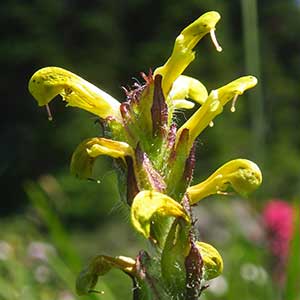Pedicularis rainierensis
Pedicularis crenulata
Mt. Rainier lousewort
meadow lousewort, scalloped-leaf lousewort
basal 2–5, blade lanceolate, 40–80 x 3–20 mm, 2-pinnatifid, margins of adjacent lobes nonoverlapping or slightly overlapping distally, serrate to 2-serrate, surfaces glabrous;
cauline 2–6, blade lanceolate, 15–70 x 5–20 mm, 1- or 2-pinnatifid, margins of adjacent lobes nonoverlapping or slightly overlapping distally, serrate, surfaces glabrous.
basal 8–10, blade narrowly elliptic to linear, 15–40 x 3–6 mm, undivided, margins of adjacent lobes nonoverlapping, 2-crenate, surfaces glabrous;
cauline 10–40, blade linear to narrowly oblanceolate, 10–60 x 2–6 mm, undivided, margins of adjacent lobes nonoverlapping, 2-crenate, surfaces glabrous.
simple, 1–4, exceeding basal leaves, each 10–50-flowered;
bracts lanceolate or subulate to trullate, 10–15 x 1–2 mm, undivided or pinnatifid, proximal margins entire, distal serrate, surfaces glabrous or tomentose.
simple, 1–10, exceeding basal leaves, each 10–50-flowered;
bracts triangular or lanceolate to oblanceolate, 10–15 x 3–4 mm, undivided, proximal margins entire, distal crenate to 2-crenate, surfaces glabrous.
1–3.5 mm.
3–3.5 mm.
calyx 7.5–11 mm, hispid to tomentose, lobes 5, linear to narrowly triangular, 4–5 mm, apex entire, glabrous or ciliate;
corolla 16–19 mm, tube light or dark yellow, 8–10 mm;
galea light or dark yellow, 8–9 mm, beakless, margins entire medially and distally, apex arching beyond abaxial lip;
abaxial lip light or dark yellow, 4–5 mm.
calyx 8.5–11 mm, hirsute along veins or glabrous, lobes 2, triangular, 0.5–1 mm, apex entire, glabrous or ciliate;
corolla 20–26 mm, tube light pink, rarely white, 12–15 mm;
galea reddish violet, sometimes white, 8–11 mm, beakless, margins entire medially, 1-toothed distally, apex arching over abaxial lip;
abaxial lip reddish violet, sometimes white, 4–8 mm.
Pedicularis rainierensis
Pedicularis crenulata
Pedicularis rainierensis is known from Mt. Rainier and the Crystal Mountain area. The species is easily confused with P. bracteosa var. latifolia, which often occurs in the same meadows. While the sizes and shapes of their flowers are nearly indistinguishable, P. rainierensis is a much smaller plant with leaves only about three fourths the size, proximal leaf lobes less than one fifth the size, inflorescences about one half the length, and the number of flowers greatly reduced in comparison to those of P. bracteosa var. latifolia.
(Discussion copyrighted by Flora of North America; reprinted with permission.)
Pedicularis crenulata is abundant in moist swales of alpine to subalpine sagebrush meadows of the mid to southern Rocky Mountains, as well as California and Nevada, where large populations with their reddish violet flowers create a distinctive swath across the otherwise green landscape. The undivided, nearly linear leaves with two-crenate margins are unique among North American species of Pedicularis. The galea bears a single apical tooth on each abaxial margin at the distal tip. Other species with the combination of two calyx lobes and undivided, linear to nearly linear leaves are P. angustifolia and P. racemosa.
(Discussion copyrighted by Flora of North America; reprinted with permission.)


